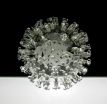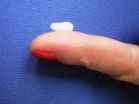(Press-News.org) Washington, D.C. (January 11, 2011) -- Whether the object of attention is a novel aspect of the universe or an enigmatic and distant colleague, listening is key to nearly any effort to seek understanding. And not just with your ears. Spectroscopy, the study of how atoms absorb and emit electromagnetic radiation, is like listening, too. The technique is central to a range of physics experiments and can be thought of as an attempt to filter out useful information from what various sensors and detectors often first "hear" as undifferentiated electromagnetic noise.
Now, a new twist on spectroscopy, described in the American Institute of Physics' in journal Review of Scientific Instruments, allows for an unprecedented level of such filtering -- one that could transform everything from the search for extraterrestrial intelligence to super-sensitive spy gear to scan hotel rooms for hidden microphones or cameras.
The technique was demonstrated on the slice of the electromagnetic spectrum containing frequencies on which terrestrial radio stations broadcast music. Current spectroscopy techniques can take such radio signals and tell you, in effect, the average volume and pitch of each moment of the music. However, if a given moment is made up of several notes played simultaneously -- a chord, say -- that fact is more or less invisible.
Or rather, it was invisible before the recent work of doctoral student Sebastian Starosielec and professor Daniel Hägele, both at Germany's Ruhr University Bochum. By stitching together a MHz-sampling card –- a radio-frequency version of a sound card -- and a multi-core graphics CPU, the two combed through a broad band of the radio spectrum in extra-fine detail. Their technical achievement, which determined in real time correlations among many thousands of pairs of frequencies, for the first time makes it easy to distinguish between a soloist and an ensemble based only on analysis of spectra.
Beyond the search for E.T. and illicit bugs, the technique could prove useful "for detecting anything that is not pure noise," says Hägele. Other applications could include better measurements of various physical systems, particularly in atomic and solid state physics, and the possibility of better communication signal recovery to be used on and off the planet's surface.
Hägele gives the following example to illustrate the power of the the technology: Imagine a TV show was broadcast daily from Mars, and the signal was received, along with a vast amount of background noise, here on Earth. After a few days "we would be able to reconstruct the show's introduction, including the theme song and images, just from spectroscopic data," he says.
INFORMATION:
The article, "Two-dimensional higher order noise spectroscopy up to radio frequencies" by Sebastian Starosielec, Rachel Fainblat, Jörg Rudolph, and Daniel Hägele appears in the journal Review of Scientific Instruments. See: http://link.aip.org/link/rsinak/v81/i12/p125101/s1
This work is supported by the German Research Foundation and Germany's Excellence Initiative.
Journalists may request a free PDF of this article by contacting jbardi@aip.org
REVIEW OF SCIENTIFIC INSTRUMENTS
Review of Scientific Instruments, published by the American Institute of Physics, is devoted to scientific instruments, apparatus, and techniques. Its contents include original and review articles on instruments in physics, chemistry, and the life sciences; and sections on new instruments and new materials. One volume is published annually. Conference proceedings are occasionally published and supplied in addition to the Journal's scheduled monthly issues. RSI publishes information on instruments, apparatus, techniques of experimental measurement, and related mathematical analysis. Since the use of instruments is not confined to the physical sciences, the journal welcomes contributions from any of the physical and biological sciences and from related cross-disciplinary areas of science and technology. See: http://rsi.aip.org/
ABOUT AIP
The American Institute of Physics is a federation of 10 physical science societies representing more than 135,000 scientists, engineers, and educators and is one of the world's largest publishers of scientific information in the physical sciences. Offering partnership solutions for scientific societies and for similar organizations in science and engineering, AIP is a leader in the field of electronic publishing of scholarly journals. AIP publishes 12 journals (some of which are the most highly cited in their respective fields), two magazines, including its flagship publication Physics Today; and the AIP Conference Proceedings series. Its online publishing platform Scitation hosts nearly two million articles from more than 185 scholarly journals and other publications of 28 learned society publishers.
Under the electron microscope, a coronavirus may resemble a spiny sea urchin or appear crownlike, (the shape from which this family of pathogens takes its name). Previously recognized as the second leading cause of the common cold in humans and for economically important diseases in many domesticated animals, a new disease form abruptly emerged as a major public health concern in 2002, when the SARS coronavirus (CoV) surfaced in Asia.
The rapid spread of the virus caused significant social and economic disruption worldwide , infecting over 8000 people with Sudden Acute ...
Multiple sclerosis (MS) is a disease caused by damage to myelin – the protective covering wrapped around the nerves of the central nervous system (CNS).
Previous studies have shown that certain white blood (immune) cells, called leukocytes, infiltrate the CNS and play a significant role in causing the damage that contributes to MS symptoms. It has also been shown that these leukocytes enter the CNS with help from a family of molecules called MMPs.
Using a mouse model, researchers have discovered that a molecular switch called EMMPRIN plays an important role in MS. The ...
Tampa, Fla. (Jan. 10, 2011) – Transplanting their own (autologous) bone marrow-derived stem cells into 48 patients with end-stage liver disease resulted in therapeutic benefit to a high number of the patients, report researchers publishing in the current issue of Cell Transplantation (19:11). Yet, the mechanism by which the infusion of CD34+ stem cells improves liver function remains elusive, they say.
The study, carried out by a team of researchers in California and in Egypt, is now freely available on-line at http://www.ingentaconnect.com/content/cog/ct/.
According ...
A team of chemists headed by Thomas Loerting from the University of Innsbruck and Hinrich Grothe from the Vienna University of Technology (TU Wien) in Austria have prepared and isolated gas-phase carbonic acid and have succeeded in characterizing the gas-phase molecules by using infrared spectroscopy. The results were published in the journal Angewandte Chemie International Edition.
In textbooks and other media the widespread belief still prevails that stable carbonic acid cannot be produced in pure form and is practically non-existent as it immediately decomposes to ...
Small children are capable of engaging in issues concerning sustainable development.Their interests and rights must be better safeguarded in rules and policy decisions that concern the education of the youngest groups of children within the EU.
This is emphasised in the report "Taking children seriously – How the EU can invest in early childhood education for a sustainable future", which was presented at a seminar in Brussels on Friday 17 December.
The body behind the report is the European Panel on Sustainable Development (EPSD), an independent research-based network ...
Berkeley — It will come as no surprise to dog owners that their four-legged friends have a flair for sniffing out the excrement of other animals. Now, biologists at the University of California, Berkeley, have trained dogs to detect the scat of other critters for the greater good – to conduct more accurate surveys of wildlife.
"Wildlife detection dogs have been mostly used in airports to detect contraband, including endangered species and wildlife products, but in recent years, interest has grown in using the dogs to help scientists track biological targets in natural ...
One of the challenges of gene therapy - a set of methodologies aimed at treating several nucleic acid diseases (DNA or RNA) - is to assure that this material arrives directly to the nucleus of the cell without losing a substantial amount along the way and without producing any undesired side effects. With this aim, scientists experiment with the use of different types of vectors, molecules capable of transporting genetic material to the correct place. Presently, natural "deactivated" viruses are the most commonly used vectors in clinical trials, their side effects however ...
Researchers at the University of Gothenburg, Sweden, have developed new methods for analysing medical databases that can be used to identify diagnostic markers more quickly and to personalise medication for allergic disorders. They could also reduce the need for animal trials in clinical studies.
Published in the journal PLoS Computational Biology, the study builds on data analyses of freely available medical databases representing studies of countless numbers of patients in the
PubMed database, and microarray data in another major database. The use of microarrays is ...
In the winter months, the mountain ranges of central Europe attract thousands of tourists for skiing, snowboarding and other outdoor sports, but conservationists fear this annual invasion may threaten indigenous bird species, including the Capercaillie. The research, published in the journal IBIS, reveals how the growth of human recreation may be a key factor in the rapidly declining population of these iconic alpine birds.
The Capercaillie (Tetrao urogallus), also known as the Wood Grouse, is the largest member of the grouse family and is renowned for its mating display. ...
Swedes drink less and less alcohol while at the same time the Swedish Alcohol Retail Monopoly's sales
are rising and statistics from Statistics Sweden show that alcohol consumption is on the increase. This
has been the trend for a long period of time. Statistics from the Centre for Social Research on Alcohol
and Drugs, SoRAD, show that alcohol consumption fell continuously in the period from 2004 to 2009,
whereas the Swedish Alcohol Retail Monopoly's sales rose by 22% over the same period. The Swedish
Alcohol Retail Monopoly's sales rose by 10% from 2008 to 2009, whereas ...



